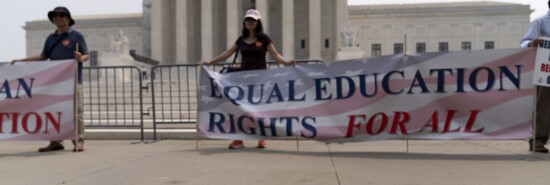
Supreme Court finally tells schools to stop discriminating on the basis of race
Washington Examiner
Video Embed
In a clarion call for equal treatment under the law, the Supreme Court today wisely and eloquently rejected race-based admissions programs at Harvard College and the University of North Carolina. Finally, justly, the time has come to make education the colorblind enterprise it should always have been.
The 6-3 court majority recognized “the broad sweep of the Equal Protection Clause” of the 14th Amendment and validated the promise in Brown v. Board of Education that “the right to a public education ‘must be made available to all on equal terms.’” Moreover, wrote Chief Justice John Roberts for the majority, “as the [Brown] plaintiffs had argued, ‘no state has any authority under the equal protection clause of the Fourteenth Amendment to use race as a factor in affording educational opportunities among its citizens.’”
CALIFORNIA REPARATIONS: WHAT NEWSOM HAS SAID AHEAD OF TASK FORCE’S FINAL PROPOSAL
These dictates, as originally written, were unmistakable. Both legally and morally, they were clearer than crystal. But cities, states, and courts for nearly 70 years erected ungainly contraptions and conceive ugly workarounds to avoid the logical imperative of Brown and the 14th Amendment. That imperative, as Roberts wrote, is that “eliminating racial discrimination means eliminating all of it.” Quoting an earlier case, he wrote that “distinctions between citizens solely because of their ancestry are by their very nature odious to a free people whose institutions are founded upon the doctrine of equality.”
In practice, the systems used by the two universities have worked to disadvantage one minority group, Asian Americans, greatly in favor of Hispanic and black applicants. In the group of students whose grades and test scores placed them in the “top academic decile,” more than 80% of black applicants to UNC were admitted, while fewer than 70% of Asians were. “In the second highest academic decile, the disparity is even starker: 83% of black applicants were admitted, while … 47% of Asian applicants were admitted.” In the third decile, 77% of black applicants and just 34% of Asian applicants gained entry.
This vast disparity in treatment wasn’t mere happenstance. Both universities specifically and deliberately put a thumb on the scales to boost the numbers of black enrollees. They admitted to doing so but argued that what Harvard called “a determinative tip” based on race is justified by various academic goals such as “acquiring new knowledge based on diverse outlooks.” The court majority rightly dismissed those goals as “not sufficiently coherent” to justify violations of the words and intent of the 14th Amendment. The universities also “fail to articulate a meaningful connection between the means they employ and the goals they pursue.”
When the chosen means so obviously undermine the ability of Asian and white students to gain admission to top universities, specifically because they are Asian or white, those means militate against the ideal of equal justice.
CLICK HERE TO READ MORE FROM THE WASHINGTON EXAMINER
Roberts’s concluding sentences are masterful. “Many universities,” he wrote, “have concluded, wrongly, that the touchstone of an individual’s identity is not challenges bested, skills built, or lessons learned but the color of their skin. Our constitutional history does not tolerate that choice.”
It is open to doubt that the academy, so steeped as it is in racialist ideology, will not try to circumvent even this plain and clear decision. But for now, we are free to hope that at long last, now that this decision is in, we will have a bright-line standard that admits no hedging, evasion, or shades of gray.
